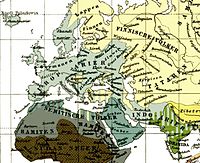| Revision as of 14:14, 15 January 2007 editJuansempere (talk | contribs)Extended confirmed users4,362 editsNo edit summary← Previous edit | Revision as of 18:29, 15 January 2007 edit undoJon Harald Søby (talk | contribs)Extended confirmed users, Pending changes reviewers6,498 editsmNo edit summaryNext edit → | ||
| Line 14: | Line 14: | ||
| The suffix ] can indicate "a similarity, not necessarily exact, to something else"<ref>http://www.bartleby.com/64/C008/037.html</ref>, so Caucasoid can mean "resembling" the ], itself a term with an inexact definition. Likewise, it can mean pertaining to or belonging to the Caucasian race. | The suffix ] can indicate "a similarity, not necessarily exact, to something else"<ref>http://www.bartleby.com/64/C008/037.html</ref>, so Caucasoid can mean "resembling" the ], itself a term with an inexact definition. Likewise, it can mean pertaining to or belonging to the Caucasian race. | ||
| In the past, the ] used the term Caucasoid as a "racial stock" term (the other "racial stocks" were Australoid, Mongoloid, and Negroid). The "racial stock" categorization scheme was replaced in 2004 with Continental Population Groups which focuses on geographic origins.<ref>http://www.nlm.nih.gov/pubs/techbull/nd03/nd03_med_data_changes.html</ref> | In the past, the ] used the term Caucasoid as a "racial stock" term (the other "racial stocks" were Australoid, Mongoloid, and Negroid). The "racial stock" categorization scheme was replaced in 2004 with Continental Population Groups which focuses on geographic origins.<ref>http://www.nlm.nih.gov/pubs/techbull/nd03/nd03_med_data_changes.html</ref> | ||
Revision as of 18:29, 15 January 2007
| It has been suggested that this article be merged into Caucasian race. (Discuss) Proposed since December 2006. |

The Caucasoid race is one of five racial categories as defined by the physical anthropologist Carleton S. Coon in 1934. The other four races that Coon defined were the Mongoloid race, the Australoid race, the Negroid race, sometimes refered as Congoid and the Capoid race. These racial classifications were made on the basis of physical features.
According to Leonard Lieberman, Rodney C. Kirk, and Alice Littlefield, The concept of race has all but been completely rejected by modern mainstream anthropology. Sarah A Tishkoff and Kenneth K Kidd state, "Despite disagreement among anthropologists, this classification remains in use by many researchers, as well as lay people."
The European Bioinformatics Institute defines Caucasoid as an ethnic group (rather than a race) which has "historical origins in Europe, North Africa or Southwestern Asia, including India". The Institute identifies eight ethnic groups: American Indian, Australian Aboriginal, Black, Caucasoid, Hispanic, Mixed, Oriental and Pacific Islander..
The Oxford English Dictionary defines Caucasoid as as noun or adjective meaning Of, pertaining to, or resembling the Caucasian race. The suffix -oid can indicate "a similarity, not necessarily exact, to something else", so Caucasoid can mean "resembling" the Caucasian race, itself a term with an inexact definition. Likewise, it can mean pertaining to or belonging to the Caucasian race.
In the past, the United States National Library of Medicine used the term Caucasoid as a "racial stock" term (the other "racial stocks" were Australoid, Mongoloid, and Negroid). The "racial stock" categorization scheme was replaced in 2004 with Continental Population Groups which focuses on geographic origins.
Footnotes
- Tishkoff, S. A., and Kidd, K. K. Implications of biogeography of human populations for 'race' and medicine: Nature Genetics, 36, S21 - S27 (2004)
- Leonard Lieberman, Rodney C. Kirk, and Alice Littlefield, "Perishing Paradigm: Race—1931-99," American Anthropologist 105, no. 1 (2003): 110-13
- http://www.nature.com/ng/journal/v36/n11s/full/ng1438.html
- http://www.ebi.ac.uk/imgt/hla/help/ethnic_help.html
- http://dictionary.oed.com/cgi/entry/50034773?single=1&query_type=word&queryword=Caucasoid&first=1&max_to_show=10
- http://www.bartleby.com/64/C008/037.html
- http://www.nlm.nih.gov/pubs/techbull/nd03/nd03_med_data_changes.html
See also
- Genetic views on race
- Caucasian race
- Caucasian peoples
- European American
- European people
- Craniofacial Anthropometry
- White people